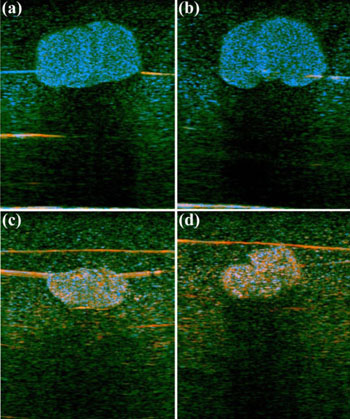Adding Color to Ultrasound Helps Differentiate Structures
By Daniel Beris
Posted on 15 Nov 2016
A new study describes how novel algorithms incorporate color identification into grey ultrasound (US) images, helping to differentiate fine details.Posted on 15 Nov 2016
Developed by University of Rochester (NY, USA) researcher Professor Kevin Parker, PhD, the mathematical model is used to characterize US scattering behavior and visualize the results as color-coding of the B-scan image. The methodology, which uses a set of mathematical functions devised in 1890 by the great mathematician Charles Hermite of France, approximates the pulse-echo formation in typical situations. Professor Parker recognized that the Gaussian weighted Hermite functions closely approximated ultrasound pulses.

Image: An increase in fatty lipids in liver tissue is shown in blue using the H-scan format, compared to normal tissue (Photo courtesy of Professor Kevin Parker).
Currently, medical US imaging scanners typically display the envelope of the reflected signal on a log scale in shades of grey. But the properties of this image and speckle patterns result in an inability to differentiate between different scattering sources that may have fundamentally different frequency-dependent scattering cross sections. The new class of images, termed H-scan, can reveal information otherwise hidden in the conventional envelope display. The study was published in the June 2016 issue of Physics in Medicine & Biology.
“If you look at an ultrasound image of the liver, there are so many things in there – veins, arteries, biliary ducts, liver cells, perhaps some scar tissue – and they’re all just displayed as black and white blobs,” said Professor Parker, of the department of electrical and computer engineering. “If there’s a large artery, it’s easy to see the wall and the blood inside. But at the finer levels of detail, it is often impossible to tell if you’re looking at a smaller artery or 10 little cells.”
“By letting us see things we can’t see now, it could be very important to individual patients. I realized if we used these, it would make our analyses of ultrasound scattering easier,” concluded Professor Parker. “So now, instead of ultrasound images showing all of these tissue structures as black and white objects, we can now classify them mathematically (by their size) and assign unique colors to unique types of scatterers.”
Ultrasound uses pulses of high-frequency sound waves that bounce back echoes when they strike cells or arteries; these echoes are also known as scattered waves. With few exceptions – such as Doppler-enhanced ultrasound imaging of blood flow – those features consist of varying shades of black, white, and gray reflecting different densities.
Related Links:
University of Rochester










 Guided Devices.jpg)



